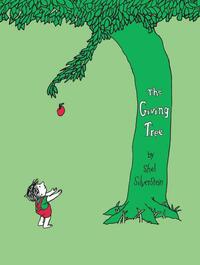Take a photo of a barcode or cover
adventurous
reflective
emotional
sad
fast-paced
Yes, the little boy didn't deserve much of anything the tree gave him. But this isn't bad to "expose children to". This book shows children that they need to be grateful for what they have been given, because most of the time they don't understand what it might have cost someone to give them what they have!
emotional
inspiring
sad
medium-paced
Plot or Character Driven:
Plot
Diverse cast of characters:
No
Flaws of characters a main focus:
Yes
emotional
reflective
slow-paced
11/10 narration. it was sad. giving enneagram type 2 who deserves to be selfish more xoxo.
I forgot how heartbreaking this story was, excuse me while I'll go curl up in a blanket and sip on some hot chocolate.
emotional
sad
fast-paced
The Giving Tree
│Grade Level: A │ Percent Grade: 90%
│Genre:Children’s Fiction │Bittersweet │ Thought-Provoking │
General Review (No Spoilers)
The Giving Tree by Shel Silverstein is a timeless and touching children’s story about the relationship between a tree and a boy. Written in simple language and accompanied by minimalistic black-and-white illustrations, the book tells a deeply emotional story that resonates with readers of all ages.
Though primarily aimed at young readers, the book’s underlying themes of selflessness, love, and the dynamics of giving and receiving make it a thought-provoking read for adults as well. Its simplicity is deceiving, as the narrative subtly touches on complex ideas such as sacrifice, environmental awareness, and human nature.
Someone who enjoys emotional, meaningful stories or allegories will find *The Giving Tree* to be a memorable experience. The relationship between the boy and the tree is symbolic of how people often take things for granted and how love can manifest in many forms, even if one side seems to give more than the other. It can also serve as a starting point for discussing bigger life lessons with young readers.
---
Spoilers Ahead!
Full Plot and Thoughts (Including Spoilers)
The Giving Tree tells the story of a boy who befriends a tree. As a child, the boy enjoys spending time with the tree, swinging from her branches and eating her apples. The tree loves the boy deeply and is happy to provide for him. However, as the boy grows older, he visits the tree less frequently, and each time he returns, he asks the tree for something to satisfy his changing needs.
The boy first asks for her apples to sell for money, and the tree happily gives them. Then, he asks for her branches to build a house, and the tree gives those too. Later, he asks for her trunk to build a boat, leaving the tree as a stump. Each time, the tree gives all that she can, even though it means taking away parts of herself. In the end, the boy, now an old man, returns one last time. He has no more requests except for a place to sit and rest, and the tree, now only a stump, offers herself as a seat.
The book's deeper meaning lies in its exploration of the nature of giving and the complexities of human relationships. The tree’s unconditional love for the boy mirrors how a parent might sacrifice everything for a child. However, the story also highlights the imbalance in relationships where one party gives endlessly while the other takes without understanding the consequences. The boy’s repeated requests can be seen as a reflection of humanity’s relationship with nature, where resources are taken without considering the long-term effects.
At its core, The Giving Tree addresses the question: What does it mean to give? The tree’s giving is both beautiful and tragic because it leads to her depletion. Some readers may view the tree’s sacrifice as a symbol of unconditional love, while others might interpret it as a cautionary tale about the dangers of selflessness, where one gives until they have nothing left. Similarly, the boy’s behavior, while not malicious, is often seen as a symbol of human selfishness or entitlement.
The ending, where the tree is happy simply to provide the boy with a place to rest, can be seen as either a satisfying conclusion to their relationship or a sad reflection of the one-sided nature of their bond. This duality is what makes the book so thought-provoking and open to interpretation. The story remains relevant across generations because of its ability to evoke different emotions and thoughts depending on the reader’s perspective.
In summary, The Giving Tree is a powerful narrative about love, sacrifice, and the dynamics of giving and receiving. Its simple storytelling conceals complex themes that linger in the minds of readers long after they finish the book.
│Grade Level: A │ Percent Grade: 90%
│Genre:Children’s Fiction │Bittersweet │ Thought-Provoking │
General Review (No Spoilers)
The Giving Tree by Shel Silverstein is a timeless and touching children’s story about the relationship between a tree and a boy. Written in simple language and accompanied by minimalistic black-and-white illustrations, the book tells a deeply emotional story that resonates with readers of all ages.
Though primarily aimed at young readers, the book’s underlying themes of selflessness, love, and the dynamics of giving and receiving make it a thought-provoking read for adults as well. Its simplicity is deceiving, as the narrative subtly touches on complex ideas such as sacrifice, environmental awareness, and human nature.
Someone who enjoys emotional, meaningful stories or allegories will find *The Giving Tree* to be a memorable experience. The relationship between the boy and the tree is symbolic of how people often take things for granted and how love can manifest in many forms, even if one side seems to give more than the other. It can also serve as a starting point for discussing bigger life lessons with young readers.
---
Spoilers Ahead!
Full Plot and Thoughts (Including Spoilers)
The Giving Tree tells the story of a boy who befriends a tree. As a child, the boy enjoys spending time with the tree, swinging from her branches and eating her apples. The tree loves the boy deeply and is happy to provide for him. However, as the boy grows older, he visits the tree less frequently, and each time he returns, he asks the tree for something to satisfy his changing needs.
The boy first asks for her apples to sell for money, and the tree happily gives them. Then, he asks for her branches to build a house, and the tree gives those too. Later, he asks for her trunk to build a boat, leaving the tree as a stump. Each time, the tree gives all that she can, even though it means taking away parts of herself. In the end, the boy, now an old man, returns one last time. He has no more requests except for a place to sit and rest, and the tree, now only a stump, offers herself as a seat.
The book's deeper meaning lies in its exploration of the nature of giving and the complexities of human relationships. The tree’s unconditional love for the boy mirrors how a parent might sacrifice everything for a child. However, the story also highlights the imbalance in relationships where one party gives endlessly while the other takes without understanding the consequences. The boy’s repeated requests can be seen as a reflection of humanity’s relationship with nature, where resources are taken without considering the long-term effects.
At its core, The Giving Tree addresses the question: What does it mean to give? The tree’s giving is both beautiful and tragic because it leads to her depletion. Some readers may view the tree’s sacrifice as a symbol of unconditional love, while others might interpret it as a cautionary tale about the dangers of selflessness, where one gives until they have nothing left. Similarly, the boy’s behavior, while not malicious, is often seen as a symbol of human selfishness or entitlement.
The ending, where the tree is happy simply to provide the boy with a place to rest, can be seen as either a satisfying conclusion to their relationship or a sad reflection of the one-sided nature of their bond. This duality is what makes the book so thought-provoking and open to interpretation. The story remains relevant across generations because of its ability to evoke different emotions and thoughts depending on the reader’s perspective.
In summary, The Giving Tree is a powerful narrative about love, sacrifice, and the dynamics of giving and receiving. Its simple storytelling conceals complex themes that linger in the minds of readers long after they finish the book.



